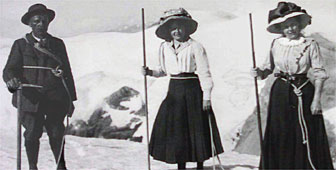Clothes made the climber

The mountaineer's uniform of today, with its lightweight, high-tech materials to keep a climber warm and dry, has evolved dramatically from early climbing garb - a Norfolk jacket, waistcoat and knickerbockers.
In the late 18th century, one climber reached the top of Western Europe’s highest mountain, Mont Blanc, wearing little more than pyjamas.
In 1854, Alfred Wills ascended the 3,700 metre high Wetterhorn in flannel cricketing trousers, and one of his contemporaries did the same on the nearby Kleine Schreckhorn.
They had ignored advice from guidebooks of the day.
The first edition of Murray’s guide published a couple decades earlier explained how to dress protectively, recommending heavy double-soled boots, thick worsted socks, gaiters and “cloth trousers, not linen, which afford no protection against rain or changes of temperature in mountain regions”.
A “frock coat is better than a shooting jacket, which, though well enough in remote places, is strange, and will attract notice in the streets of a foreign town,” Murray warned. “A straw hat is the most pleasant covering for the head, from its lightness and the protection afforded to the face by a broad brim.”
Alpine knickerbockers
The standard uniform became the Norfolk jacket, waistcoat and knickerbockers. The single-breasted coat had a belt, could be buttoned to the neck and had plenty of button-up pockets for essentials like matches, small knives and a brandy flask. The knickerbockers were often double-seated to prevent bruising the backside during rocky descents.
Climbers were told which materials provided the best insulation and dried easily, and which colours protected against the sun’s harmful rays. They learned which spare clothes to carry and how much material to take in case something needed patching.
Virginia Woolf remembered how her father, Sir Leslie Stephen, would walk proudly around London in his long tweed coat – stained yellow from climbing ropes.
As far as female climbers were concerned, few were as bold as Aubrey le Blond, who would make ascents in trousers, having hid her skirt under a boulder at the start of a climb.
Most women wore skirts made of heavy, rough cloth, usually in grey or brown so stains wouldn’t show.
According to author Claire Eliane Engel, the climber, Lucy Walker “never dreamt of dressing as a man; she used to wear a white printed dress to which some decent shape had to be restored after a strenuous expedition, a thankless task no doubt, after a rock climb or a long tramp down the last moraine.”
A hemmed skirt could be shortened with safety pins or buttons during a climb, then let down again when the woman returned to the valley.
The British climbers’ clothing made an impression on their guides, and mountain peasants soon found themselves wearing a formal uniform similar to that of their employers.

In compliance with the JTI standards
More: SWI swissinfo.ch certified by the Journalism Trust Initiative
You can find an overview of ongoing debates with our journalists here . Please join us!
If you want to start a conversation about a topic raised in this article or want to report factual errors, email us at english@swissinfo.ch.